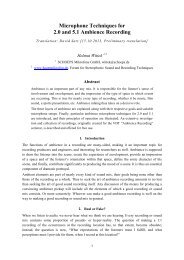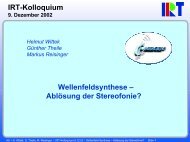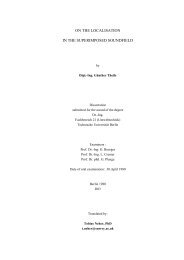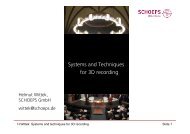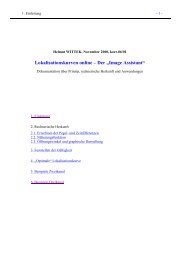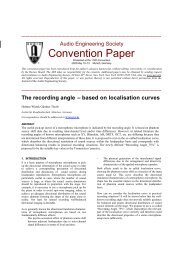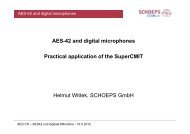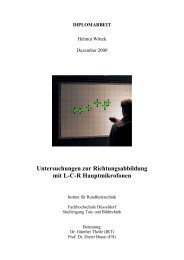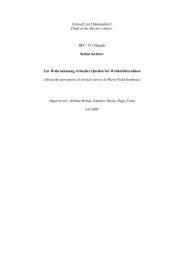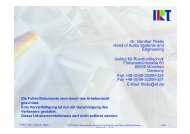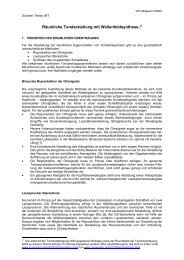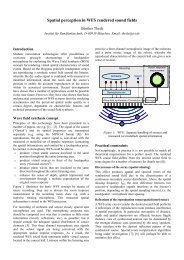sound colour properties of wfs and stereo 0. perception mechanism ...
sound colour properties of wfs and stereo 0. perception mechanism ...
sound colour properties of wfs and stereo 0. perception mechanism ...
You also want an ePaper? Increase the reach of your titles
YUMPU automatically turns print PDFs into web optimized ePapers that Google loves.
duce rather good results in terms <strong>of</strong> the qualitative distribution<br />
<strong>of</strong> the results. The squared correlation coefficient is R 2<br />
= <strong>0.</strong>76 for the multiple regression based on both predictors.<br />
Figure 2-6 shows the prediction against the mean <strong>colour</strong>ation<br />
grades <strong>of</strong> the experiment. The st<strong>and</strong>ardized residuals<br />
<strong>of</strong> the regression based on predictor SD are shown in<br />
Figure 2-7, where positive residuals correspond to an underestimation<br />
<strong>of</strong> the <strong>colour</strong>ation <strong>and</strong> negative residuals to<br />
an overestimation <strong>of</strong> the <strong>colour</strong>ation. The results show that<br />
the prediction quality apparently is dependent on the type<br />
<strong>of</strong> system. The systems containing aliasing (solid triangles<br />
in Figure 2-6) are mostly underestimated in their <strong>colour</strong>ation,<br />
whereas the systems without aliasing but with a<br />
<strong>stereo</strong>phonic contribution are mostly overestimated. This<br />
means that the perceived <strong>colour</strong>ation <strong>of</strong> the <strong>stereo</strong>phonic<br />
systems is lower than was predicted by the spectral alterations.<br />
This leads in to confirming the hypothesis that<br />
<strong>stereo</strong>phonic <strong>perception</strong> is different from conventional<br />
auditory <strong>perception</strong>.<br />
3. CONCLUSIONS<br />
WFS <strong>properties</strong> compared to <strong>stereo</strong><br />
The experiment revealed the <strong>sound</strong> <strong>colour</strong> <strong>properties</strong> <strong>of</strong><br />
WFS. Spatial aliasing introduces <strong>colour</strong>ation to the virtual<br />
sources. The <strong>colour</strong>ation can be rather well predicted by an<br />
analysis <strong>of</strong> the spectral alterations <strong>of</strong> the ear signals.<br />
Colouration generally is dependant on the aliasing frequency<br />
<strong>and</strong> the shape <strong>of</strong> the aliasing, i.e. the peak/notch<br />
distance <strong>and</strong> the spectral deviation. Stereo showed the least<br />
<strong>colour</strong>ation <strong>of</strong> all systems.<br />
OPSI technique<br />
The <strong>sound</strong> <strong>colour</strong> <strong>properties</strong> <strong>of</strong> a WFS virtual source can<br />
be optimised by avoiding aliasing. Both theoretical <strong>and</strong><br />
practical investigations have shown how an introduction <strong>of</strong><br />
<strong>stereo</strong>phonic techniques to WFS can help avoiding <strong>colour</strong>ation<br />
artefacts. The idea <strong>of</strong> the OPSI concept is the coexistence<br />
<strong>of</strong> the low frequency WFS localisation <strong>properties</strong><br />
<strong>and</strong> the high frequency <strong>sound</strong> <strong>colour</strong> <strong>properties</strong> known<br />
from <strong>stereo</strong>. Experiments that are not described in this<br />
paper [15] revealed that apart from a certain reduction <strong>of</strong><br />
the listening area, the localisation <strong>properties</strong> <strong>of</strong> an OPSI<br />
system are similar to a corresponding WFS system.<br />
Perception <strong>of</strong> <strong>stereo</strong><br />
Stereo showed the least <strong>colour</strong>ation <strong>of</strong> all systems. Also the<br />
spectral alterations were smaller for the <strong>stereo</strong> sources.<br />
This means that the spectrum <strong>of</strong> the source is <strong>of</strong>ten more<br />
flat in the case <strong>of</strong> <strong>stereo</strong> compared with typical WFS.<br />
However, both the <strong>stereo</strong> <strong>and</strong> the OPSI sources were<br />
graded better than it was predicted from the spectral alterations<br />
<strong>of</strong> the ear signals. Hence, the experimental results<br />
show that the <strong>perception</strong> <strong>of</strong> <strong>stereo</strong> is to be regarded differently<br />
from WFS <strong>perception</strong>. This suggests the existence <strong>of</strong><br />
some kind <strong>of</strong> de<strong>colour</strong>ation which leads to an improvement<br />
<strong>of</strong> <strong>sound</strong> <strong>colour</strong> <strong>perception</strong> in <strong>stereo</strong> reproduction<br />
similar to the de<strong>colour</strong>ation <strong>of</strong> a <strong>sound</strong> source in a reflective<br />
environment. The segregation cannot be considered as<br />
leading to an ideal separation with regard to localisation<br />
<strong>and</strong> <strong>sound</strong> <strong>colour</strong> <strong>perception</strong>. This leads to the hypothesis<br />
<strong>of</strong> a partial de<strong>colour</strong>ation in <strong>stereo</strong>phonic <strong>perception</strong>. It can<br />
be considered an interpretation <strong>of</strong> Theile’s association<br />
model.<br />
REFERENCES<br />
[1] Theile, G., 1980: “On the localisation in the superimposed<br />
<strong>sound</strong> field”, Dissertation Technische Universität<br />
Berlin, available: www.hauptmikr<strong>of</strong>on.de/theile.htm .<br />
[2] Theile, G., 1991: “On the Naturalness <strong>of</strong> Two-<br />
Channel Stereo Sound”, Journal <strong>of</strong> the Audio Engineering<br />
Society, Vol.39, No.10, pp.761-767<br />
[3] Wittek, H., 2001: “JAVA-Applet Image Assistant 2.0<br />
<strong>and</strong> documentation” on www.hauptmikr<strong>of</strong>on.de/ima2.html<br />
[4] Zurek, P.M., 1979: “Measurements <strong>of</strong> binaural echo<br />
suppression”, Journal <strong>of</strong> the Acoustical Society <strong>of</strong> America<br />
Vol.66, pp.1750–1757.<br />
[5] Brüggen, M., 2001: “Coloration <strong>and</strong> binaural decoloration<br />
in natural environments”, Acustica 87, 400–406.<br />
[6] Brüggen, M., 2001: “Sound coloration due to reflections<br />
<strong>and</strong> its auditory <strong>and</strong> instrumental compensation”,<br />
Dissertation Ruhr-Universität Bochum<br />
[7] Bilsen, 1977: “Pitch <strong>of</strong> noise signals - Evidence for a<br />
‘central spectrum’ “, Journal <strong>of</strong> the Acoustical Society <strong>of</strong><br />
America, Vol.61, No.1, January 1977.<br />
[8] Kates, J.M., 1985: “A central spectrum model for the<br />
<strong>perception</strong> <strong>of</strong> coloration in filtered Gaussian noise”, Journal<br />
<strong>of</strong> the Acoustical Society <strong>of</strong> America, Vol.77, No.4,<br />
pp.1529-1534<br />
[9] Salomons, A. M., 1995: “Coloration <strong>and</strong> binaural<br />
decoloration <strong>of</strong> <strong>sound</strong> due to reflections”, Dissertation,<br />
Delft University.<br />
[10] Supin, A., et al., 1999: “Ripple depth <strong>and</strong> density<br />
resolution <strong>of</strong> rippled noise”, Journal <strong>of</strong> the Acoustical Society<br />
<strong>of</strong> America, Vol.106 (5), November<br />
[11] Horbach, U., Pellegrini, R., Felderh<strong>of</strong>f, U., Theile,<br />
G., 1998: “Ein virtueller Surround Sound Abhörraum im<br />
Ü-Wagen”, Proceedings 20 th Tonmeistertagung, Karlsruhe.<br />
[12] Rathbone, B., Fruhmann, M., Spik<strong>of</strong>ski, G., Theile,<br />
G., 2000: “Untersuchungen zur Optimierung des BRS-<br />
Verfahrens (Binaural Room Scanning)”, Proceedings 21 st<br />
Tonmeistertagung, Hannover, pp. 92-106.<br />
[13] Atal, B. et al., 1962: “Perception <strong>of</strong> coloration in<br />
filtered gaussian noise-short-time spectral analysis by the<br />
ear”, Proceedings 4 th ICA, Copenhagen.<br />
[14] Raatgever, J. <strong>and</strong> Bilsen, F.A., 1986: "A central spectrum<br />
theory <strong>of</strong> binaural processing. Evidence from dichotic<br />
pitch", Journal <strong>of</strong> the Acoustical Society <strong>of</strong> America, Vol.<br />
80(2), p.429-441<br />
[15] Wittek, H., Rumsey, F., Theile, G., 2007: “Perceptual<br />
enhancement <strong>of</strong> wavefield synthesis by <strong>stereo</strong>phonic<br />
means”. Journal <strong>of</strong> the Audio Engineering Society, Vol.55,<br />
No.9, September 2007, pp 723-751.



